I’ll start out with the one piece of advice that will help the most: work with an instructor. Most model plane clubs are full of people who are happy to take the time to teach you to fly. Our club will help anybody who just shows up at our flying site; we even have a plane for them to learn on. It’s usually not hard to find a club near you. The leading model airplane organization in this country, the Academy of Model Aeronautics, can provide, with its inexpensive membership, liability insurance. They also have a good magazine and a useful web site. The site, www.modelaircraft.org, has a button that allows you to search for clubs near you.
Another source for help is your local hobby shop. Most shops know where local clubs and flying sites are located, and some have instructors who can help you learn.
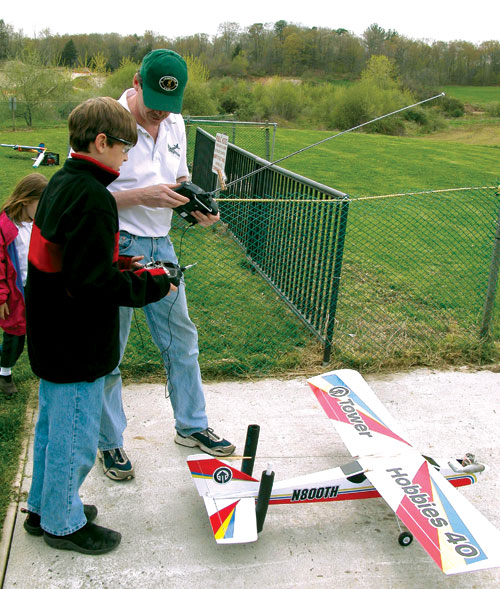
Even though my preference is to train with electrics, firebreathing trainers are also suitable. Thomas Foley prepares to fly his Tower Hobbies Trainer 40 ARF using a JR buddy box system. Instructor Dave Baron has the ability to take control of the plane at any time (note both radios are connected by a cord). On this, his 6th flight, Thomas made his first unassisted landing. He practiced flying and landing on the Great Planes RealFlight R/C Simulator for a few hours (see screenshot at top) before taking to the air at the flying fieldhe said this was a big help.
If you don’t have a club or friendly model pilot nearby, or if the local club is not as welcoming as it might be, then you can learn on your own. It will take longer, and you’ll have more crashes, but it can be done. This series of articles is designed to help in either case.
HOW TO CHOOSE AN INSTRUCTOR
You need an RC pilot to learn from, not a big-plane pilot. Pilots of full-size craft usually require just as much training to fly radio-controlled (RC) models as non-pilots. If the instructor wants to start you off with lots of theory, unless you like lots of theory, they’re probably not right for you. You might want to watch your prospective instructor fly his or her own plane first. Pay attention to the landings especially: if they are smooth and realistic, and down the center of the runway (if there’s a runway), the person is probably a good pilot. Close in is not as important as smooth. Landing well is one of the most difficult parts of flying model planes.
Because learning can be stressful (especially when the model seems about to crash), find someone who is easy for you to work with. In my experience, “field preachers,” who seem to know everything and who loudly proclaim their knowledge at every occasion, often make poor teachers.
Some clubs have designated instructors, who are usually expert at helping you learn to fly.
The use of a “buddy box” (a system of dual control where you and the instructor each have a control unit and the instructor can instantly take over in case of problems) is recommended. It is not necessary, but it is much easier and faster for an instructor to throw a switch than to grab the transmitter from you if you get into trouble.
When you work with an instructor, he or she will probably do the take offs and landings. After you become proficient at flying, you will then learn to take off. Last, you will learn to land. After reading this series, you’ll know what skills you must master first to bring your model down safely.
Summary: You can learn by yourself, but working with an instructor is best. Choose a compatible instructor; a good place to find one is a local model airplane club. Using a buddy box is recommended.
WHAT TO LOOK FOR IN A FIRST MODEL PLANE
It must be:
- Easy to fly-after all, you are a beginner
- Durable-it should stand up to a few beginner mistakes
- Inexpensive-an expensive plane makes most of us nervous
- Light and smallish-a beginner shouldn’t be flying a fast,
dangerous object - Suitable for the weather where you live
- Easy to build-spend your time flying
- Appealing to you-it’s your airplane!
Let’s take a look at my current favorite trainer, the Graupner Tipsy offered by Hobby Lobby. I think its a handsome, sleek, and modern design. It is very easy to fly and designed to get itself out of trouble. You just stop the motor and let go of the control stick and it will usually right itself. Though it is easy to fly, it controls so well that even advanced pilots enjoy flying it. The Tipsy has very few parts, the wing comes in one piece, and the plastic parts can be readily repaired with white glue or epoxy should they break. The airplane costs $50, which is at the low end of almost-ready-to-fly (ARF) models. If you do somehow completely break the wing and fuselage, you will probably not harm the motor, prop, or radio gear, so the expense for replacing the model is not very great. Just put the same gear into the new plastic parts.
The Tipsy weighs 10 ounces (300 grams) yet it can be flown even if there is a breeze – up to about 8 mph (4 m/sec). Because it is light, and because the nose is made of foam plastic, it would probably not break a window even if it hit one. It is very easy to put together, the parts are well-made and fit perfectly. In fact, it is the best example of molded foam plastic that I have ever seen.
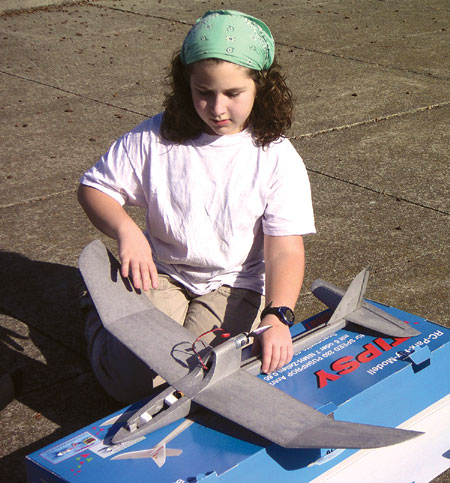
A student puts together her Tipsy at the field. The plane fits back in the box the kit came in; handy for preventing damage during transport.
The Tipsy has another feature that I like in a trainer: it has a “pusher” propeller. This means that the propeller is behind the wing. First of all, this is a big safety plus. It also means you won’t have problems such as broken props or bent propeller shafts when you make a hard landing, as often happens with planes whose propellers are up front. Because the Tipsy is aerodynamically efficient, it can also be used as a slope-soaring trainer, if you live near good slopes. If all this is not enough reason to like a model, then let me add that its flying time on a charge is over 20 minutes and, after being built, it fits back in the box it comes in for safe, easy transport. Summary: Be careful in your selection of a first model. Have a checklist (such as the one above) with you when you are evaluating a model as a trainer
CHOOSE ELECTRIC POWER FOR YOUR FIRST PLANE
In my opinion, there is no question that it is best to start with an electric-powered model. Even if you love tinkering with gas engines, remember that you first want to learn to be a good pilot. After that, you can go in any direction you want with RC models.
Why electric? Because they are much simpler to set up, you dont have to bother with starting equipment, and there is no clean-up after each flight. Mostly, however, because electrics are just plain reliable. You spend less time fooling with the motor and spend more time flying. A typical training flight is five to ten minutes long, and any decent electric trainer has at least that duration.
Electrics are silent so neighbors don’t complain about the noise, and many are small enough to fly in a school yard. Many very easy to build or pre-built models are available. The smoothness of an electric means that planes and RC gear are not subject to nearly as much vibration-planes last longer. Remem-ber, at this stage you are learning to fly, not to run engines. Time spent in the air is learning-to-fly time. Maximize it..
I am sorry to have to report that you may get advice that says that electrics aren’t “real” RC models, that only wimps fly them, that it’s best to learn on something noisier and messier because “that’s what you will eventually end up flying.” Others say that electrics are too heavy to fly well or don’t have enough duration to learn on. Most of the anti-electric folk are way behind the times. While there are a few bad electric models out there, the same is true for all kinds of models. A good instructor knows which are which.
None of the criticisms of electrics I mentioned are true. Some never were. Always remember, though, that this is a hobby. We do it because we enjoy it. If the element that makes it fun for someone is having a fuel-powered reciprocating engine to tinker with and love, then I salute them for their particular interest. I wouldn’t want to take away their fun for a moment. But the point of this series is learning to fly, and that is best done with the least troublesome model you can find. In the 21st century, that’s electric power.
Summary: Start off with an electric- powered trainer.
FLYING SITES
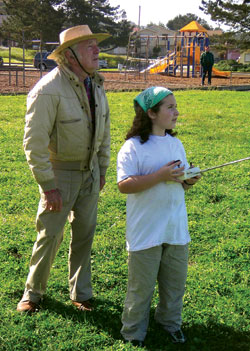
The instructor stands near the student and keeps a careful eye on the model. (Ralph Voorhees teaches Aenea Raskin, both of the San Francisco Vultures).
You can’t fly without a place to fly at. To start learning on your own, please find an empty space that is at least as large as a football or soccer field. You can easily launch a model from a much smaller space than you can land in, and this fools many people into trying to fly in inappropriate locations. This is one of the most common beginner mistakes, and is the cause of many a lost or broken model! You will need lots of area while you are learning to fly and especially when it is time to land. It is best if the usual wind direction is parallel to a long edge of the field.
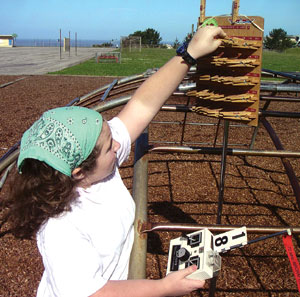
At a popular flying site, a frequency control board might be available. The text explains how it is used. Note that the channelnumber (18) is prominently displayed on the transmitter.
If there are obstructions, like buildings, a hill, or a line of trees just upwind from the flying site, the air over the field can be turbulent, making flying difficult or impossible. Make sure that this is not the case at any site you choose to try to learn at, preferably by having an experienced flyer try it (a big hint that a field is unsuitable is when an expert refuses to fly there). The school where I have taught flying has a beautiful soccer field, but it is surrounded by tall trees, and unless the wind is nearly still, model planes are tossed around mercilessly. In spite of its size and lush grass, it is not a good site at which to learn, and we have to go elsewhere.
USING A SIMULATORImagine that if every time you made a mistake and damage a model, someone came up to you and gave you a brand new one, ready to fly. That’s pretty much what you get when you fly a computer RC simulator. Many of these graphic-intensive computer programs fly very much like a model does, and you can learn a lot (and save a lot of time and money) by practicing on a simulator. Though I am an experienced flyer, I still use my RC simulator when learning new tricks.
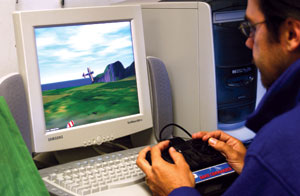
Harry Oestreicher flies the Ikarus Pro RC flight simulator.
It is important to get one which has a box which is a close match to your RC transmitter in shape and size, or which allows your RC transmitter to be used to control the models on the display. There are, as far as I know, no first-rate simulators for Linux or Apple Macintosh operating systems. So you will have to use a Windows-based machine.
Computer-based simulators are not a “second best” choice for learning. While nothing replaces experience with a real model in the air, remember that even full-size aircraft are now taught mostly via computer simulation. If you have a computer, get an RC simulator. It will save you money, building time, and even some embarrassment at the field. A few of the better simulators would include Great Planes RealFlight Generation 2, Ikarus Aerofly Pro, Dave Brown RCFS 2001 and Hobby Lobby’s Cockpit Master. We will be taking a close look at several of the flight sims in future issues.
Good flying!
Another alternative is an indoor site, if you can find one large enough and have an appropriate model.
It is important to remember that if somebody else is flying a model plane on the same frequency (that is, on the same channel) as yours, and they are closer than 2 or 3 miles, there is a chance that your plane can lose control due to radio interference from the other transmitter. At the same time, your transmitter might cause the other plane to also crash. Every time you turn on your transmitter you should be asking yourself: Is there any chance I might be interfering with another model?
If there is a local field where people tend to fly, it is therefore best to fly there, too. Then you can ask if anybody is on the same channel as your model, and if somebody is, you can take turns flying. At popular flying sites, there may be a frequency control board, often with pins (often clothespins) you take out to indicate you are using a particular frequency. If your pin isnt there, it isnt safe to fly. Ask how the system works if you find one at a local fieldat some fields you clip the pin to your antenna, at ours you put the pin at the top of the board (that way we dont lose pins).
For any trainer, the wind must not be too strong. Very often one site will be windier than another, which is another factor in choosing a flying site. Often two sites, just a few blocks apart, will have quite different wind conditions, so it pays to walk or drive around, feeling the wind at each potential flying field. Some of the trainers can be flown only if there is almost no wind at all In many places, it can be frustrating waiting for a windless day. Many locations offer a calm period in the morning or evening nearly every day in certain seasons, in which case you can take advantage of the daily lulls. You have to become sensitive to the wind to fly any kind of aircraft! If you have a place where a complete calm is rare, choose a trainer that can handle some wind.
Summary: Until you are an experienced flyer, it is hard to judge the suitability of a flying site. An empty area the size of a soccer or football field, without upwind obstructions, is usually OK. It is best to fly where others have found success.
Links
Dave Brown Products, www.dbproducts.com, (513) 738-1576.
Hobby Lobby Internatinal, www.hobby-lobby.com, (615) 373-1444.
Ikarus USA, www.ikarus-usa.com, (239) 690-0003.
RealFlight, distributed exclusively by Great Planes Model Distributors, www.realflight.com, (800) 682-8948.
 Fly RC Magazine WE LIVE RC
Fly RC Magazine WE LIVE RC
